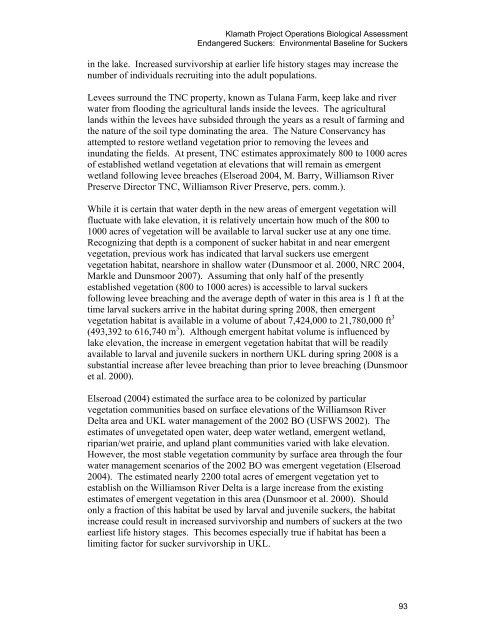Our new Biological Assessment is out - Klamath Basin Crisis
Our new Biological Assessment is out - Klamath Basin Crisis
Our new Biological Assessment is out - Klamath Basin Crisis
You also want an ePaper? Increase the reach of your titles
YUMPU automatically turns print PDFs into web optimized ePapers that Google loves.
<strong>Klamath</strong> Project Operations <strong>Biological</strong> <strong>Assessment</strong><br />
Endangered Suckers: Environmental Baseline for Suckers<br />
in the lake. Increased survivorship at earlier life h<strong>is</strong>tory stages may increase the<br />
number of individuals recruiting into the adult populations.<br />
Levees surround the TNC property, known as Tulana Farm, keep lake and river<br />
water from flooding the agricultural lands inside the levees. The agricultural<br />
lands within the levees have subsided through the years as a result of farming and<br />
the nature of the soil type dominating the area. The Nature Conservancy has<br />
attempted to restore wetland vegetation prior to removing the levees and<br />
inundating the fields. At present, TNC estimates approximately 800 to 1000 acres<br />
of establ<strong>is</strong>hed wetland vegetation at elevations that will remain as emergent<br />
wetland following levee breaches (Elseroad 2004, M. Barry, Williamson River<br />
Preserve Director TNC, Williamson River Preserve, pers. comm.).<br />
While it <strong>is</strong> certain that water depth in the <strong>new</strong> areas of emergent vegetation will<br />
fluctuate with lake elevation, it <strong>is</strong> relatively uncertain how much of the 800 to<br />
1000 acres of vegetation will be available to larval sucker use at any one time.<br />
Recognizing that depth <strong>is</strong> a component of sucker habitat in and near emergent<br />
vegetation, previous work has indicated that larval suckers use emergent<br />
vegetation habitat, nearshore in shallow water (Dunsmoor et al. 2000, NRC 2004,<br />
Markle and Dunsmoor 2007). Assuming that only half of the presently<br />
establ<strong>is</strong>hed vegetation (800 to 1000 acres) <strong>is</strong> accessible to larval suckers<br />
following levee breaching and the average depth of water in th<strong>is</strong> area <strong>is</strong> 1 ft at the<br />
time larval suckers arrive in the habitat during spring 2008, then emergent<br />
vegetation habitat <strong>is</strong> available in a volume of ab<strong>out</strong> 7,424,000 to 21,780,000 ft 3<br />
(493,392 to 616,740 m 3 ). Although emergent habitat volume <strong>is</strong> influenced by<br />
lake elevation, the increase in emergent vegetation habitat that will be readily<br />
available to larval and juvenile suckers in northern UKL during spring 2008 <strong>is</strong> a<br />
substantial increase after levee breaching than prior to levee breaching (Dunsmoor<br />
et al. 2000).<br />
Elseroad (2004) estimated the surface area to be colonized by particular<br />
vegetation communities based on surface elevations of the Williamson River<br />
Delta area and UKL water management of the 2002 BO (USFWS 2002). The<br />
estimates of unvegetated open water, deep water wetland, emergent wetland,<br />
riparian/wet prairie, and upland plant communities varied with lake elevation.<br />
However, the most stable vegetation community by surface area through the four<br />
water management scenarios of the 2002 BO was emergent vegetation (Elseroad<br />
2004). The estimated nearly 2200 total acres of emergent vegetation yet to<br />
establ<strong>is</strong>h on the Williamson River Delta <strong>is</strong> a large increase from the ex<strong>is</strong>ting<br />
estimates of emergent vegetation in th<strong>is</strong> area (Dunsmoor et al. 2000). Should<br />
only a fraction of th<strong>is</strong> habitat be used by larval and juvenile suckers, the habitat<br />
increase could result in increased survivorship and numbers of suckers at the two<br />
earliest life h<strong>is</strong>tory stages. Th<strong>is</strong> becomes especially true if habitat has been a<br />
limiting factor for sucker survivorship in UKL.<br />
93










